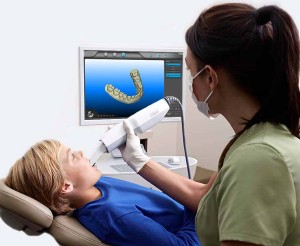Digital impressions represent cutting-edge technology that allows dentists to create a virtual, computer-generated replica of the hard and soft tissues in the mouth using lasers and other optical scanning devices. The digital technology captures clear and highly accurate impression data in mere minutes, without the need for traditional impression materials that some patients find inconvenient and messy. The impression information then is transferred to a computer and used to create restorations, often without the need for stone models.
Benefits of Digital Impressions
- Improved image/impression quality for better-fitting restorations
- Less chair time
- No need for distasteful impression materials that cause some patients to gag
- More comfortable, less anxious experience for patients and the dental team
- Reduced possibility of impression-taking errors and elimination of material inaccuracies for fewer restoration mistakes.
- The scan of the teeth being restored, as well as the opposing teeth and bite, can be completed in just three to five minutes.
- The digital impression can be stored electronically indefinitely, which saves space, contributes to efficient recordkeeping, and supports a paper-free environment.
- Green dentistry and eco-friendly aspects include eliminating the need for disposable plastic trays and impression materials, which otherwise would be polluting landfill space; digital data is eliminated with the “delete” button.
- With milled models, you have a solid model. Dies are precision-fit in the model with no movement, and all dies are captured in one model. This gives greater accuracy when restoring multiple units, such as veneer cases. There is no contamination from the patient and no die spacer is required.
Digital scanners offer many benefits that aren’t possible with traditional impression techniques, from time savings to patient education and accuracy to the ease of storing electronic data. Combine the benefits with the fact that the learning curve is small, and it’s clear that implementing a digital scanner in the dental practice is a “no brainer,”




